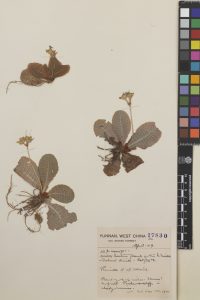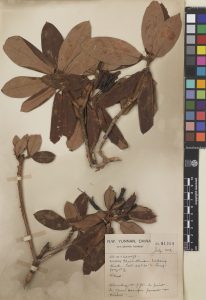George Forrest was a prolific plant hunter; it’s estimated that here in the herbarium there are around 31,000 pressed plant specimens collected by Forrest and his team of local collectors. To celebrate what would be George Forrest’s 142th birthday we have explored both our physical and digital collections to see what more we can discover about his legacy.
So far we have captured digital data for 31% of Forrest’s specimens, of which 2,691 are type specimens, those specimens that, alongside a description, define what that particular species is for all of time. Forrest was a pioneer, exploring regions of China new to plant science and horticulture. It was therefore very likely that he would discover new species on his expeditions. In particular, these are likely to be in families containing ornamentals that would have been of value to horticulture, as often his trips were sponsored by garden owners and firms.
So what did the digital collections tell us?
For one thing it confirmed that he did indeed discover many new species. Out of the Forrest specimens databased so far, 87% of his Primulaceae specimens, and 68% of his Ericaceae specimens were new to science when he collected them. These are largely species from within the ornamental genera Rhododendron and Primula. Many of the species descriptions for these were published by Forrest himself, often in collaboration with the Regius Keepers of RBGE Isaac Bayley Balfour and William Wright Smith, during the time he was actively collecting. This fast publication is significant, since specimens can lie in herbarium cabinets for decades waiting to be rediscovered and identified, the average time currently being around 35 years. This suggests he knew that the material he was bringing back was new to botany and horticulture.
So the data provides some answers but also some interesting questions…
Why did Forrest collect disproportionately for some families and genera over others? Was it because he was an expert within these genera, and therefore recognised he was discovering a new species? The short time between collecting and publishing new species could suggest this.
Or are his collections rich in type specimens for specific plant families because the geographical area was largely unexplored, and the habitat was rich in Ericaceae and Primulaceae species?
Finally, and most exciting of all, there are still specimens collected by Forrest in the herbarium which have not yet been identified to species level. How many of these could be new species still to be described?


